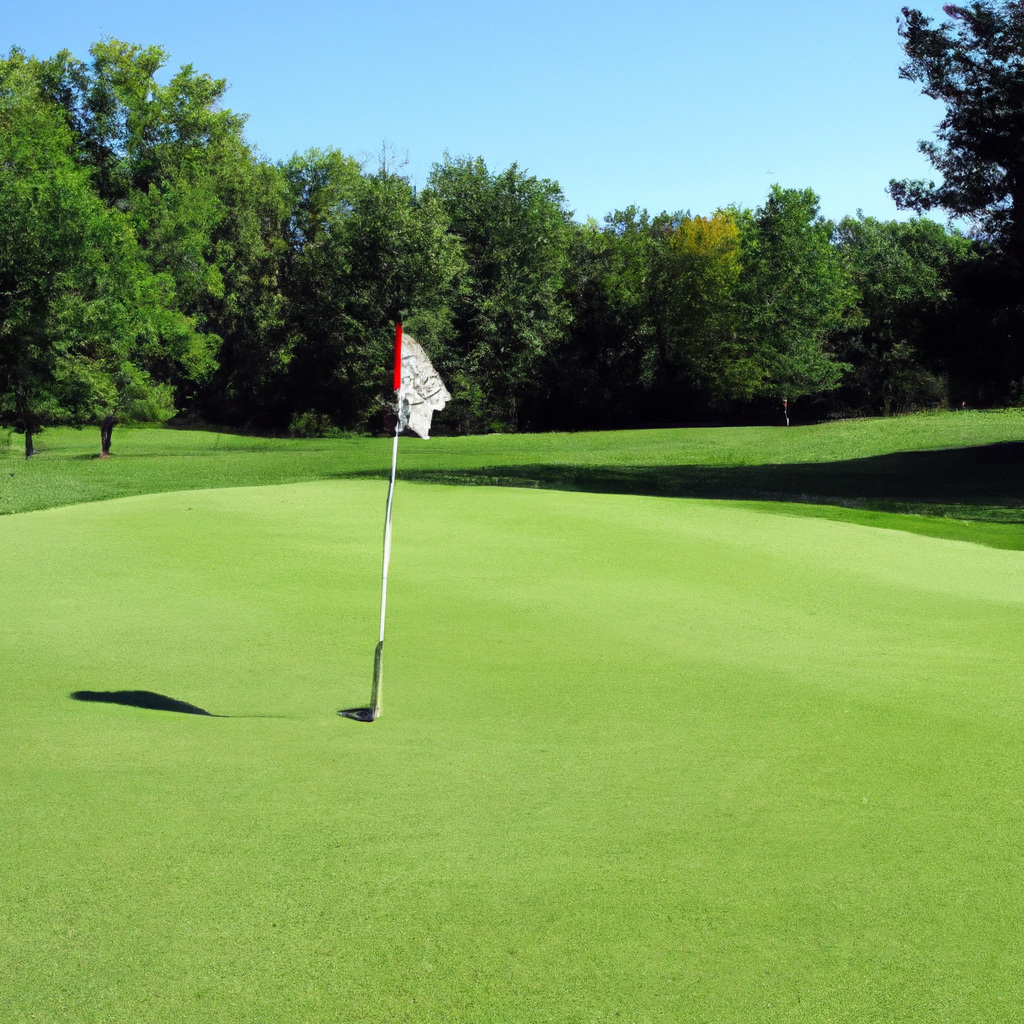Imagine stepping onto a beautiful, lush golf course. As you take in the scenery, you may find yourself wondering: how many holes are there in total? You’ll be delighted to discover that in this article, we will explore the intriguing world of golf courses and the number of holes that make up these challenging and exciting landscapes. So grab your clubs and join us on this journey as we uncover the secrets behind the number of holes found on a golf course.

The Origin of Golf Courses
Golf as a sport has a long and fascinating history, dating back to the 15th century in Scotland. The exact origins of the game are still a subject of debate among historians, but it is widely believed that golf emerged from a popular medieval pastime known as “colf.” As the sport gained popularity, the need for designated playing areas arose, and thus the concept of golf courses was born.
Brief history of golf
Golf, as we know it today, began to take shape in Scotland during the 17th and 18th centuries. The first written records of golf mentions the formation of various golf societies and the establishment of clubs and courses. The Old Course at St. Andrews, dating back to the early 15th century, is one of the oldest and most iconic golf courses in the world. From Scotland, the game of golf spread to England and beyond, eventually becoming a beloved sport worldwide.
Introduction to golf courses
A golf course is a carefully designed and maintained area where the sport of golf is played. It typically consists of a series of fairways, greens, and hazards. The number of holes on a golf course varies, but the most common configuration is 18 holes. Golf courses can range in size from compact 9-hole layouts to sprawling 72-hole complexes. These courses are meticulously crafted to provide a challenging and enjoyable experience for golfers of all skill levels.
Standard Number of Holes
Traditional number of holes
The traditional number of holes on a golf course is 18. This configuration has become synonymous with the sport and is the standard for professional tournaments such as the U.S. Open and the Masters. A round of golf on an 18-hole course typically takes around four to five hours, allowing players to experience a full range of challenges and shot-making opportunities.
Evolution of hole numbers
While 18 holes has become the norm, it is interesting to note that golf courses didn’t always consist of this specific number of holes. In the early days of the sport, golf courses often had fewer holes, typically ranging from 10 to 12. It wasn’t until the mid-19th century that the concept of 18 holes became more widely adopted. This evolution was largely influenced by the desire for a standardized round of golf.

Factors Influencing Hole Count
Golf course size
The size of a golf course is a significant factor in determining the number of holes it can accommodate. Smaller courses with limited land availability may opt for fewer holes to fit within their space constraints. On the other hand, larger courses with more extensive landscapes may have the freedom to offer a greater number of holes.
Geographical constraints
The geographical features of the land on which a golf course is built also play a role in determining the hole count. Courses situated in hilly or mountainous regions may have to work around natural obstacles, which can affect the layout and the number of holes that can be included.
Land availability
The availability of land is a crucial consideration when planning a golf course. Developers must assess the available space and determine how many holes can be comfortably accommodated. In some cases, land scarcity may lead to smaller courses with fewer holes, while ample land availability can allow for larger and more extensive layouts.
Budget limitations
Budgetary constraints can also play a significant role in determining the number of holes on a golf course. Building and maintaining a golf course requires a substantial investment, and the available funds may dictate the scale and complexity of the project. Courses with limited budgets may opt for a smaller number of holes to ensure the financial feasibility of the endeavor.
Player demand
Golf courses also consider the demand from players when deciding the number of holes. Some players may prefer shorter rounds, while others enjoy a more extended and challenging experience. Course owners and operators aim to strike a balance by offering varied hole counts that cater to different preferences and skill levels.
Variations in Hole Count
9-hole courses
9-hole courses are a popular option for both beginners and experienced golfers seeking a quicker round of golf. These courses provide a condensed experience that can be completed in approximately two hours, making them ideal for golfers with limited time. Additionally, 9-hole courses are often more affordable and easier to maintain, making them a common choice for smaller communities and golf practice facilities.
18-hole courses
18-hole courses are the most common and widely recognized configuration. These courses offer a full round of golf that tests a player’s skills across a range of challenges. The 18-hole layout provides a perfect balance between variety and endurance, allowing golfers to experience a comprehensive game while still maintaining an efficient pace of play.
27-hole courses
27-hole courses are a unique and versatile option that combines elements of both 9-hole and 18-hole layouts. These courses can be played as three separate 9-hole loops, allowing golfers to customize their rounds and experience a different combination of holes each time they play. The additional holes provide increased variety and help alleviate congestion on popular courses.
36-hole courses
36-hole courses offer an extensive golfing experience with two full rounds of 18 holes. These courses are often affiliated with resorts or destination golf complexes, catering to dedicated golf enthusiasts who enjoy spending a significant amount of time on the greens. The 36-hole format allows for tournament play, offering players the opportunity to test their skills in a competitive setting.
45-hole courses
45-hole courses are less common but can be found in a few select locations. This configuration provides an additional level of choice for golfers, allowing them to create their preferred combination of holes from the available options. Courses with 45 holes often feature three 18-hole courses and one 9-hole course, providing both flexibility and variety.
54-hole courses
54-hole configurations are primarily found in large and prestigious golf resorts. These expansive complexes offer multiple course options, each consisting of 18 holes. Golfers visiting these resorts can enjoy an extensive range of playing experiences, choosing from a variety of course designs and difficulty levels.
72-hole courses
72-hole courses are the epitome of golfing luxury, often associated with world-renowned golf resorts and prestigious tournaments. These expansive complexes provide a range of courses, each offering distinct challenges and stunning scenery. Playing on a 72-hole course is a truly immersive golf experience, allowing players to explore the beautiful landscapes while testing their skills on a grand scale.
Non-standard hole counts
In addition to the common variations mentioned above, golf courses can have non-standard hole counts that are tailored to specific needs or design preferences. These unique configurations may include 10-hole courses, 12-hole courses, or even more unconventional layouts. These non-standard hole counts offer golf course designers the creative freedom to craft innovative and engaging playing experiences.
Popular Hole Count Configurations
The regulation 18-hole course
The regulation 18-hole course is the most widely recognized and prevalent configuration in the world of golf. This setup provides a well-rounded experience, showcasing a diverse range of holes that challenge different aspects of a golfer’s game. A typical 18-hole course features a mixture of par 3, par 4, and par 5 holes, with various hazards strategically placed to test a player’s skill and precision.
The 9-hole executive course
The 9-hole executive course, also known as a short course, is designed for golfers seeking a quicker and more relaxed round. These courses are typically shorter in length and feature mostly par 3 holes with the occasional par 4 hole. The executive course provides an excellent option for beginners, juniors, and those looking to improve their short game skills.
The 27-hole championship course
The 27-hole championship course offers a unique playing experience that combines the advantages of 9-hole and 18-hole layouts. These courses are divided into three distinct 9-hole loops, offering golfers the opportunity to play a different combination of holes each time. The 27-hole configuration also allows for hosting major tournaments, providing a versatile and challenging setting for competitors.
Advantages of Different Hole Counts
Flexibility for different skill levels
The availability of golf courses with varying hole counts allows players of different skill levels to enjoy the game. Beginners and casual golfers may find the shorter 9-hole or executive courses less overwhelming, providing them with a more manageable and enjoyable experience. On the other hand, seasoned golfers and professionals can test their skills on the more demanding and intricate 18-hole or championship courses.
Ability to accommodate more players
Golf courses with multiple hole configurations have the advantage of accommodating a larger number of players. The flexibility offered by various hole counts enables courses to host more golfers simultaneously, reducing congestion and allowing for a smoother pace of play. This is particularly beneficial during peak seasons or when hosting tournaments and events.
Variety of course design
Different hole counts allow golf course designers to create a diverse range of course layouts and designs. Each hole count presents unique opportunities for creating strategic challenges and memorable playing experiences. Whether it’s the strategic placement of hazards, the integration of natural elements, or the overall flow of the course, varying hole counts contribute to the richness and variety of the golfing landscape.
Reduced timeframe for play
Shorter hole configurations, such as 9-hole courses or executive layouts, offer a time-efficient option for golfers with busy schedules. These courses can be played in a fraction of the time required for a full 18-hole round, providing an opportunity for a quick game during lunch breaks, after work, or in between other commitments. The reduced time commitment also makes golf more accessible to beginners or those new to the sport.
Design Considerations for Hole Count
Course layout and flow
The selection of hole count plays a crucial role in designing the layout and flow of a golf course. Golf course architects carefully consider the placement of holes, hazards, and features to create a harmonious progression throughout the course. The number of holes influences the routing and arrangement of fairways, greens, and other elements, ensuring that the course offers a seamless and enjoyable playing experience.
Challenges and hazards
The choice of hole count directly impacts the distribution of challenges and hazards on a golf course. Different hole counts allow designers to strategically position bunkers, water hazards, and other obstacles in a way that tests golfers’ skills and decision-making abilities. The selection of holes also influences the overall difficulty of the course, catering to golfers seeking a range of challenges, from gentle to highly demanding.
Aesthetics and landscaping
The number of holes on a golf course can influence the overall aesthetics and landscaping choices. Each hole provides an opportunity to showcase beautiful landscapes, diverse vegetation, and stunning vistas. From the fairways and greens to the surrounding areas, golf course designers aim to create visually pleasing environments that enhance the overall experience for players and spectators alike.
Environmental impact
Designers must consider the environmental impact of the golf course when determining the hole count. The size and layout should be well-balanced, taking into account the natural features of the land and any environmental considerations. By choosing an appropriate hole count, careful land management practices can be implemented, minimizing disruption to local ecosystems and conserving natural resources.
Notable Golf Course Hole Counts
The Old Course at St. Andrews – 18 holes
The Old Course at St. Andrews, often referred to as the “Home of Golf,” is one of the most prestigious and historic courses in the world. With its iconic 18-hole layout, the Old Course has played host to numerous Open Championships and remains a pilgrimage site for golf enthusiasts. Its unique design and challenging features make it a staple in any discussions about notable hole counts.
Pebble Beach Golf Links – 18 holes
Pebble Beach Golf Links, situated along the scenic California coastline, is renowned for its breathtaking views and challenging layout. As an 18-hole course, it has gained international acclaim and has been the stage for major tournaments, including the U.S. Open. The combination of rugged cliffside fairways, ocean vistas, and strategic design makes Pebble Beach a remarkable example of an 18-hole course.
Pinehurst Resort Course No. 2 – 18 holes
Pinehurst Resort Course No. 2, located in North Carolina, is a cherished golfing destination with a rich history. Designed by renowned architect Donald Ross, the course offers a true test of skill with its complex greens and meticulously placed bunkers. Hosting multiple U.S. Open Championships, Course No. 2’s 18-hole configuration has played a significant role in cementing its reputation as one of the premier golf courses in the United States.
The Links at Spanish Bay – 18 holes
The Links at Spanish Bay, part of the Pebble Beach Resorts collection, is another notable 18-hole course that showcases both natural beauty and strategic design. This Scottish-style links course embraces its coastal setting, offering challenging fairways and sensational ocean views. With its unique hole count and stunning location, the Links at Spanish Bay has become a favorite destination for avid golfers seeking a one-of-a-kind experience.
Future of Golf Course Hole Counts
Increasing popularity of 9-hole courses
In recent years, there has been a surge in the popularity of 9-hole courses. These shorter and more time-efficient layouts cater to the modern golfer’s busy lifestyle, providing a convenient way to enjoy the sport without committing to a full 18-hole round. As golf continues to adapt to the changing demands and preferences of players, the prominence of 9-hole courses is expected to grow.
Growing interest in shorter rounds
Beyond 9-hole courses, there is a general trend towards shorter rounds of golf. Many golfers appreciate the option to play a quick 6-hole or 12-hole game, allowing them to enjoy the sport in a more condensed timeframe. This flexible approach to hole counts appeals to both experienced players looking for variety and new golfers looking for a less time-consuming introduction to the game.
Emerging trends in course designs
Golf course architects are continually pushing the boundaries of traditional hole counts, experimenting with innovative designs and configurations. Concepts such as reversible and modular courses, where the hole count can be adjusted according to demand or conditions, are emerging. These dynamic designs create exciting possibilities for golfers, providing fresh challenges and a new level of customization in their playing experiences.
Conclusion
The number of holes on a golf course is a fundamental aspect that shapes the sport and the experiences it offers. From the traditional 18-hole format to the multitude of variations available today, golf courses of different sizes and hole counts cater to the diverse preferences and needs of players. Whether it’s the flexibility for different skill levels, the ability to accommodate more players, the variety of course design, or the reduced time commitment, various hole counts contribute to the richness and accessibility of the game. As golf continues to evolve, the importance of hole count flexibility will remain paramount in ensuring that the sport remains inclusive, enjoyable, and adaptable to the changing demands of players worldwide.

















